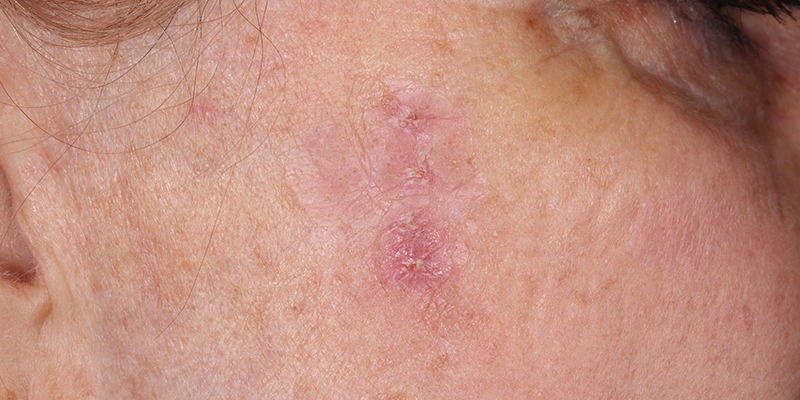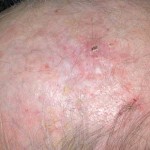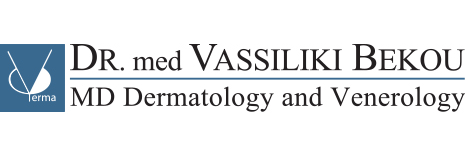
( For the texts and pictures books, publications, guidelines for example in awmf.org and contributions of colleagues were consulted.)
Actinic Keratosis
 Actinic keratoses correspond to chronic keratinization disorders of the skin, caused by cumulative UV radiation. Keratoses / precancerous lesions are keratinizing, rough, scaly, more or less reddened, lentil to large cent lesions, predominantly in sun-exposed areas. Accordingly, they are found increasingly in older people, and are found mainly on chronically sun-exposed skin areas (eg, forehead, nose, cheeks, bald head, back of the hand). These premalignant lesions, as potentially in the course of time (months to years) can develop actinic keratoses from malignant tumors such as squamous cell carcinoma. For therapy could local, non-surgical measures be sufficient.The most important factors for developing skin cancer is the type of skin and exposure to sunlight. The best precaution for people at risk is to avoid sun exposure and use of appropriate protective clothing and sunscreen.
Actinic keratoses correspond to chronic keratinization disorders of the skin, caused by cumulative UV radiation. Keratoses / precancerous lesions are keratinizing, rough, scaly, more or less reddened, lentil to large cent lesions, predominantly in sun-exposed areas. Accordingly, they are found increasingly in older people, and are found mainly on chronically sun-exposed skin areas (eg, forehead, nose, cheeks, bald head, back of the hand). These premalignant lesions, as potentially in the course of time (months to years) can develop actinic keratoses from malignant tumors such as squamous cell carcinoma. For therapy could local, non-surgical measures be sufficient.The most important factors for developing skin cancer is the type of skin and exposure to sunlight. The best precaution for people at risk is to avoid sun exposure and use of appropriate protective clothing and sunscreen.
Therapy
Since actinic keratoses are superficial, a surgical procedure is usually not necessary.
Possible treatments are :
1 curettage
2 cryotherapy (freezing)
in combination with a treatment with a topical gel, containing diclofenac ( Solaraze ) for
3 months
3 dermabrasion (sanding treatment)
4 electrosurgical removal
5 laser therapy: ablative laser, franktionale laser
6 drug therapy:
A good, non-invasive method, the drug treatment with the immunomodulator imiquimod (Aldara) or with the cytostatic drug 5-fluorouracil (Actikerall, Efudix) represents the substances are applied in cream form for 6 weeks to actinic keratoses. This creates an inflammatory response, so that the abnormal cells are destroyed and removed. The method is simple to use and provides excellent cosmetic results. Disadvantage and limiting is, however, the inflammation that transforms the treated area for 4-6 weeks in dark red, crusted and sometimes oozing area.
The method is also used to treat basal cell carcinoma shallow well suited, especially in areas, which is not like surgery due to possible unsightly scarring (eg, decolletage).
7 photodynamic therapy:
When infestations over large areas and heavily photodamaged skin first a photosensitizing substance (5 -delta-aminolevulinic acid) is applied to the skin. It must act for 3 hours under a light-tight association. After this time, the substance is isolated due to an altered metabolism in malignant cells, but not in healthy cells. By a subsequent irradiation with a special “cold” infrared light, the malignant cells are selectively destroyed and replaced by normal cells. The irradiation leads for a few days to a sunburn-like reaction with redness, scaling, and occasionally swelling and crusting. The treatment is generally carried out 2 times at intervals of 2 weeks. The treatment is effective and the cosmetic results are usually excellent.
8 chemical peeling:
Certain acids (trichloroacetic acid, fruit acid, kojic acid, etc.) are applied extensively after degreasing the skin. This results in a two-dimensional destruction of the epidermis cells to be replaced by healthy cells within one week. In addition to the desired distance from the light- damaged cells, the firming and smoothing effects are so good that the method is often used for purely cosmetic reasons for skin rejuvenation. However, a disadvantage is a 1-2-week downtime due to a crusting of the skin.
9 post-treatment:
Further treatment as an adjunctive therapy in a lighter infestation is a diclofenac-containing gel (Solaraze), which must be applied for 3 months, 2x daily to the skin. It hardly causes inflammatory reactions. Important is a consistent light protection for the future, to prevent further UV damage. Here special new products with high protection in the UVB and UVA range are suitable. In addition, the head should be protected from the sun by hats or caps. Regular bi-annual inspections are strongly recommended.
Side effects :
In the treatment of pigmentary changes or even scarring can occur.
